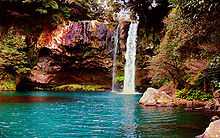Tourism in South Korea

Tourism in South Korea refers to the tourist industry in the Republic of Korea. In 2012, 11.1 million foreign tourists visited South Korea, making it the 20th most visited country in the world,[1] up from 8.5 million in 2010.[2] Most non-Korean tourists come from Japan, China, Taiwan and Hong Kong. The recent popularity of Korean popular culture, often known as the "Korean wave", in these countries has increased tourist arrivals. Seoul is the principal tourist destination for visitors; popular tourist destinations outside of Seoul include Seorak-san national park, the historic city of Gyeongju and subtropical Jeju Island. Traveling to North Korea is not normally possible without a special permission, but in recent years organized group tours have allowed groups of South Korean citizens to visit Mount Kumgang.
International and Domestic tourism
The majority of the South Korean tourist industry is supported by domestic tourism. Thanks to the country's extensive network of trains and buses, most of the country lies within a day's round trip of any major city. International tourists come primarily from nearby countries in Asia. Japan, China, Hong Kong and Taiwan together account for roughly 75% of the total number of international tourists.[3] In addition, the Korean wave has brought increasing numbers of tourists from Southeast Asia and India. The Korea Tourism Organization (KTO) is targeting 100,000 arrivals from India in 2013.[4]
International tourists typically enter the country through Incheon International Airport, near Seoul, which was found to be the world's best airport in 2006.[5] Also international airports in Busan and Jeju are frequently used.
Statistics
| Year | Number of international tourists arriving in S. Korea [6] |
|---|---|
| 1970 | 173,335 |
| 1980 | 976,415 |
| 1990 | 2,958,839 |
| 2000 | 5,321,792 |
| 2005 | 6,022,752 |
| 2008 | 6,890,841 |
| 2009 | 7,817,533 |
| 2010 | 8,797,658 |
| 2011 | 9,794,796 |
| 2012 | 11,140,028 |
| 2013 | 12,175,550 |
| 2014 | 14,201,516 |
In 2012, travel and tourism (domestic and international) directly contributed KRW26.7 trillion to South Korean GDP and directly supported 617,500 jobs in the country. [7]
Governmental support
Through the Ministry of Culture and Tourism and its constituent Korea Tourism Organization, the South Korean government regulates tourism within South Korea. The Korea Tourism Organization aims to attract 10 million inbound visitors to South Korea for the year 2010.
Tourist attractions

South Korea's historical tourist attractions include the ancient capitals of Seoul, Gyeongju and Buyeo.
Some natural landmarks include the peaks of the Baekdudaegan, particularly Seorak-san and Jiri-san, the caves of Danyang and Hwanseongul, and beaches such as Haeundae and Mallipo.
Apart from Jeju island, there are many smaller islands. Excursion ferries are quite common along the south and west coasts and also to Ulleung-do Island, off the east coast. Limited tourism mainly by South Koreans to the Liancourt Rocks (Dokdo) has grown in recent years as a result of the political status of the rocks.
Many local districts hold annual festivals, such as the Boryeong Mud Festival and the Cheongdo Bullfighting Festival.
Events
South Korea has hosted many international events, including the 1988 Summer Olympics, the 1993 Taejon Expo, the 2002 FIFA World Cup (jointly hosted with Japan), and the 2005 APEC conference. Also, the 2018 Winter Olympics will be held in Pyeongchang.
See also
- Visa policy of South Korea
- KTO (Korea Tourism Organization)
- Korean culture
- Contemporary culture of South Korea
- Tourism in Gyeongju
- List of Korea-related topics
- List of South Korean tourist attractions
References
- ↑ UNTWO (June 2008). "UNTWO World Tourism Barometer, Vol.5 No.2" (PDF). Retrieved 2008-10-15.
- ↑ Kolesnikov-Jessop, Sonia (2010-11-11). "South Korea Sets Its Sights on Foreign Tourists". nytimes.com.
- ↑ Organisation for Economic Co-operation and Development, NATIONAL TOURISM POLICY REVIEW REPUBLIC OF KOREA, July 2002, Page 2, Table 2
- ↑ "South Korea in hot pursuit of Indians". TTGmice. Retrieved 14 March 2013.
- ↑ Phillips, Don (March 7, 2006). "Travelers call Incheon best airport". International Herald Tribune.
- ↑ "Visitor Arrivals". Korea Tourism Organization. Retrieved 25 April 2014.
- ↑ "2013 Travel & Tourism Economic Impact Report South Korea". World Travel & Tourism Council. Retrieved 2013-11-27.
Further reading
- Korean Overseas Information Service (2004). Handbook of Korea 4th ed. Seoul: Hollym. ISBN 1-56591-212-8.
External links
| Wikivoyage has a travel guide for South Korea. |
- South Korea travel and tourism at DMOZ
- , the Korea Tourism Organization’s London office website for info on travelling from the UK to Korea (English)
- Tour2Korea, the Korea Tourism Organization’s website (English)
- Ministry of Culture and Tourism (English)
- , Park Air Travel Ltd Specialists in Travel to Korea - London office website (English)
| ||||||||||||||